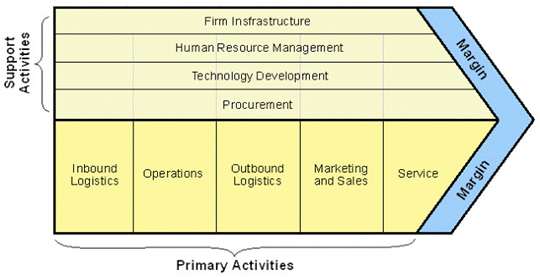VALUE CHAIN ANALYSIS
It is defined as activities that take
place in a business and relates them to an analysis of the competitive strength
of the business. At every level of the product manufacturing, each activity
adds to its value and it is the reason that makes the customers to pay for the
product. There is a chain of activities that at each level help making a
product and to reach at its final shape and finished products. A firm is said
to be earning profit or is profitable when the value it receives exceeds the
cost that it put in making that product. In analyzing the firm’s competitive
position the key concept is creating the value for buyer’s that exceeds the
costs of production. Value chain analysis is an approach presented by Micheal
Porter to understand its importance as a building block of competitive
advantage. It describes two different types of activities;
(1) Primary
Activities
Activities that are directly
concerned with creating and delivering a product (e.g. assembling the parts of
a product or putting different components of a product together)
(2) Support
Activities,
Activities that are
not directly involved in production, but that may increase effectiveness or
efficiency of a firm (e.g. human resource management, staffing, intellectual
capital etc.).

Primary activities
Inbound Logistics
This is primarily associated with receiving,
storing and distributing inputs to the product. It depicts how material is
stored, retrieved and used for the production activity. How material is saved
and kept and how it is stored to be used when needed. It also takes into
account the availability of enough quantity available when needed to use. It deals
with returns to suppliers, scheduling of vehicle, inventory control and
material handling. It further deals with;
·
Time to use the material
·
Processing the material when requested
·
Plant capacity
·
Plant scheduling
·
Location of distribution facilities
·
Layout of warehouse
·
Increasing efficiency by operations
Operations
·
Efficient ways of operating the plant to minimize
efficiency
·
Maximizing and maintaining the product quality
·
Fulfilling the order in given time
·
Customer handling
·
Customer satisfaction
·
Effective way of handling and minimizing the customer
complaints
Outbound logistics
·
Order fulfillment
·
On time delivery
·
Dealing with emergencies (delivering the product
where needed or supply is short)
·
Managing the inventory
·
Shipment and orders
·
Audit
·
Transaction management
·
Accuracy
·
Quick and in time response
Marketing and sales
·
Pricing
·
Total cost analysis
·
Cost benefit comparison
·
Understanding the product’s value
·
Innovative approaches to promote and advertise the
product
·
Identification of customer needs and targeted audience
·
Understanding customer needs
·
Capturing needs of the customers
Service
·
Quick response to customer needs and emergencies
·
Problem
solutions
·
Call centers
·
24/7 service availability
·
Putting customer at the front line
·
Customer survey
·
Quality of service
·
Personnel training and proper staffing
Support Activities:
General Administration:
·
Firm’s infrastructure
·
Audit
·
Accounts
·
Staff
·
Finance
·
Communication systems
·
Planning and strategies
·
Flow of information
·
Chain of command
·
Relationships with stakeholders
·
Effective information technology application
·
Automated systems and value chain mechanism
·
Planning systems to achieve goals and objectives
Human Resource Management
·
Manpower development
·
Employees training
·
Labor skills
·
Recruitment
·
Reward and incentives
·
Good relations with trade unions
·
Motivating employees and workers by intrinsic and
extrinsic rewards
·
Appreciating the efforts of the employees
Technology development
·
R&D
·
Innovations and discoveries
·
Positive collaboration between R&D and other
departments
·
Scanning the lifecycle of a product
·
Improvement in products, process and quality
·
Adopting new technologies
·
Substituting labor with technology to reduce cost by
one time investment
Procurement
·
Raw material procurement to reduce cost and optimize
quality
·
Procuring machinery
·
Selecting and analyzing the alternative sources of
inputs to maintain bargaining power of a buyer and to minimize the dependence
on one supplier
·
Maintaining good relations with suppliers
·
Supplies mechanism
Linking Value Chain
Analysis to Competitive Advantage
A business that
undertake its business activities efficiently by product differentiation, cost
minimization, efficient customer handling and by putting more emphasis on
value-chain activities perform better than its competitors. By undertaking
these business activities a business achieve its competitive advantage more
quickly than its competitors. Value-chain analysis is a tool to analyze the
performance and to trace where firm needs to focus more on.
No comments:
Post a Comment